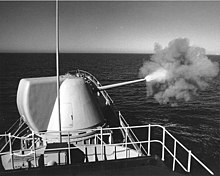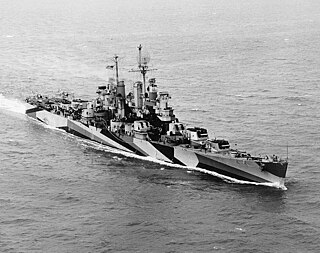
USS Duluth was a Cleveland-class light cruiser of the United States Navy, which were built during World War II. The class was designed as a development of the earlier Brooklyn-class cruisers, the size of which had been limited by the First London Naval Treaty. The start of the war led to the dissolution of the treaty system, but the dramatic need for new vessels precluded a new design, so the Clevelands used the same hull as their predecessors, but were significantly heavier. The Clevelands carried a main battery of twelve 6-inch (152 mm) guns in four three-gun turrets, along with a secondary armament of twelve 5 in (127 mm) dual-purpose guns. They had a top speed of 32.5 knots.

USS Long Beach (CLGN-160/CGN-160/CGN-9) was a nuclear-powered guided missile cruiser in the United States Navy and the world's first nuclear-powered surface combatant. She was the third Navy ship named after the city of Long Beach, California.

USS Parsons (DD-949/DDG-33) began her career as a Forrest Sherman-class destroyer of the United States Navy. She was named in honor of Rear Admiral William S. Parsons (1901–1953), who worked on the Manhattan Project during World War II.

The 18 Forrest Sherman-class destroyers comprised the first post-war class of US destroyers. Commissioned beginning in 1955, these ships served until the late 1980s. Their weaponry underwent considerable modification during their years of service. Four were converted to guided-missile destroyers. This class also served as the basis for the Charles F. Adams-class guided-missile destroyers.
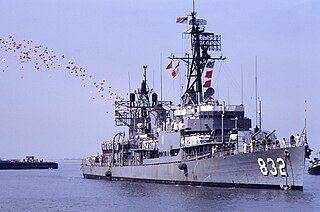
The Gearing class was a series of 98 destroyers built for the U.S. Navy during and shortly after World War II. The Gearing design was a minor modification of the Allen M. Sumner class, whereby the hull was lengthened by 14 ft (4.3 m) at amidships, which resulted in more fuel storage space and increased the operating range.

USS Higbee (DD/DDR-806) was a Gearing-class destroyer in the United States Navy during World War II. She was the first U.S. warship named for a female member of the U.S. Navy, being named for Chief Nurse Lenah S. Higbee (1874–1941), a pioneering Navy nurse who served as Superintendent of the U.S. Navy Nurse Corps during World War I.

The Fletcher class was a class of destroyers built by the United States during World War II. The class was designed in 1939, as a result of dissatisfaction with the earlier destroyer leader types of the Porter and Somers classes. Some went on to serve during the Korean War and into the Vietnam War.

USS Agerholm (DD-826) was a Gearing-class destroyer of the United States Navy. She was the only ship named for Harold Crist Agerholm, a Private First Class (Pfc.) in the 2nd Marine Division of the United States Marine Corps. He was killed during the assault on Saipan, and posthumously awarded the Medal of Honor.

USS Warrington (DD-843) was a Gearing-class destroyer that served the U.S. Navy from the end of World War II to the Vietnam War, when she was damaged by two underwater explosions, causing her to be listed as "beyond repair" and excessed to the Navy of the Republic of China.

USS Rowan (DD-782) was a Gearing-class destroyer of the United States Navy, the fourth Navy ship named for Vice Admiral Stephen C. Rowan (1805–1890).

USS Gurke (DD-783) was a Gearing-class destroyer of the United States Navy, in service from 1945 to 1976. She was transferred to Greece in 1977 and served as Tombazis until 1997.
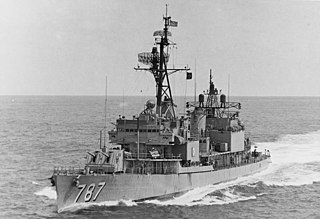
USS James E. Kyes (DD-787) was a Gearing-class destroyer of the United States Navy, named for Commander James E. Kyes (1906–1943).

USS Shelton (DD-790) was a Gearing-class destroyer of the United States Navy, the second Navy ship named for Ensign James A. Shelton (1916–1942), who was killed in the Battle of Midway.

USS Carpenter (DD/DDK/DDE-825) was a Gearing-class destroyer of the United States Navy, named for Lieutenant Commander Donald M. Carpenter (1894–1940).

USS Hanson (DD/DDR-832) was a Gearing-class destroyer of the United States Navy that was named after First Lieutenant Robert M. Hanson of the United States Marine Corps squadron VMF-215. Hanson was a quintuple ace and was posthumously awarded the Medal of Honor.
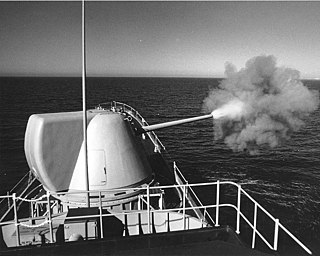
The U.S. Navy's Major Caliber Lightweight Gun (MCLWG) program was the 8"/55 caliber Mark 71 major caliber lightweight, single-barrel naval gun prototype (spoken "eight-inch-fifty-five-caliber") that was mounted aboard the destroyer USS Hull in 1975 to test the capability of destroyer-sized ships to replace decommissioned cruisers for long-range shore bombardment. United States naval gun terminology indicates the gun fired a projectile 8 inches (203 mm) in diameter, and the barrel was 55 calibers long (barrel length is 8" × 55 = 440" or 11.165 meters.)

